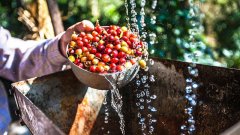Introduction to the Flavor characteristics of Water-washed Coffee beans

Professional coffee knowledge exchange more coffee bean information please follow the coffee workshop (Wechat official account cafe_style)
Due to the shortcomings of the sun method, the Dutch invented the method of washing coffee beans in the mid-18th century, which was widely favored. The biggest difference from the sun method is that it uses fermentation to remove the skin. In the process of treatment, wash coffee and beans with water to get a clean sour taste.
As in the first step of the sun method, remove the shoddy beans, then use the pulping machine (pulp planer) to remove the peel and pulp of the coffee fruit, throw it into the sink and ferment for 16-36 hours, and the fermentation bacteria dissolve the pectin.
In order to remove the residue of fermentation bacteria and impurities, the coffee beans are washed again, and then the coffee fruit is dried by machine to reduce the moisture content to 10% Murray 14%. Finally, the use of shelling machine to remove the silver skin on the coffee beans can be completed.
The disadvantage is that, as the name implies, most of the water washing method requires water, but this method can not be adopted in some countries where there is a lack of water resources. The process of washing coffee and beans with water is also relatively tedious, and the cost is much higher than that of the sun method.
Advantages
After layers of screening and cleaning, the appearance and taste will be cleaner and more uniform. And because the flesh is removed in the first place, you don't have to worry about mildew as much as the sun.
Coffee beans usually have bright and clean acidity because they ferment acidic substances in the fermentation tank.
"after we remove the pulp, we put the coffee with endocarp in the fermentation tank, and the fermentation promotes the sweetness, chocolate and fruit flavor of the coffee." but one of the challenges of fermentation is temperature control.
Since temperature can affect the degree of fermentation, it will also negatively affect the stability and flavor of the process.
"when we remove the pulp and put the coffee with endocarp into the water, the water will help prolong the fermentation time, resulting in a softer mellow thickness, rich acidity and more elegant flavor characteristics of the coffee."
Important Notice :
前街咖啡 FrontStreet Coffee has moved to new addredd:
FrontStreet Coffee Address: 315,Donghua East Road,GuangZhou
Tel:020 38364473
- Prev

Explain in detail the water washing method of coffee and raw beans: how long is the water washing method? What are the precautions?
Professional coffee knowledge exchange more coffee bean information Please follow the coffee workshop (Wechat official account cafe_style) every coffee producer needs to understand several factors that affect coffee quality, namely, estate management, raw bean processing after coffee harvest, coffee roasting, and coffee brewing. Each of these four stages will affect the quality of coffee. Coffee producers do not have to
- Next

Coffee Bean Solar method Yemen Moka Ethiopia Hara Brazil Indonesia Coffee Solar method
Professional coffee knowledge exchange more coffee bean information please follow the coffee workshop (Wechat official account cafe_style)
Related
- What is the meaning of lactic acid fermentation with coffee bean treatment?
- How to judge the state of foam by sound?
- How does the latte pull out the unicorn pattern? Come to get for a little trick to improve the flower pull!
- Will flower pulling affect the taste of the latte?
- Do you know the history of coffee?
- The difference between honey treatment and sun washing what is raisin honey treatment?
- What kind of milk can a novice use to make coffee foam to keep the foam longer? The correct method and skills of milking tutorial sharing
- Why do washed coffee beans taste sour? Flavor characteristics of washed Coffee
- Introduction to the skill of how to practice the size and height of water injection around the circle of hand-brewed coffee
- How do beginners practice coffee flower drawing from scratch?

